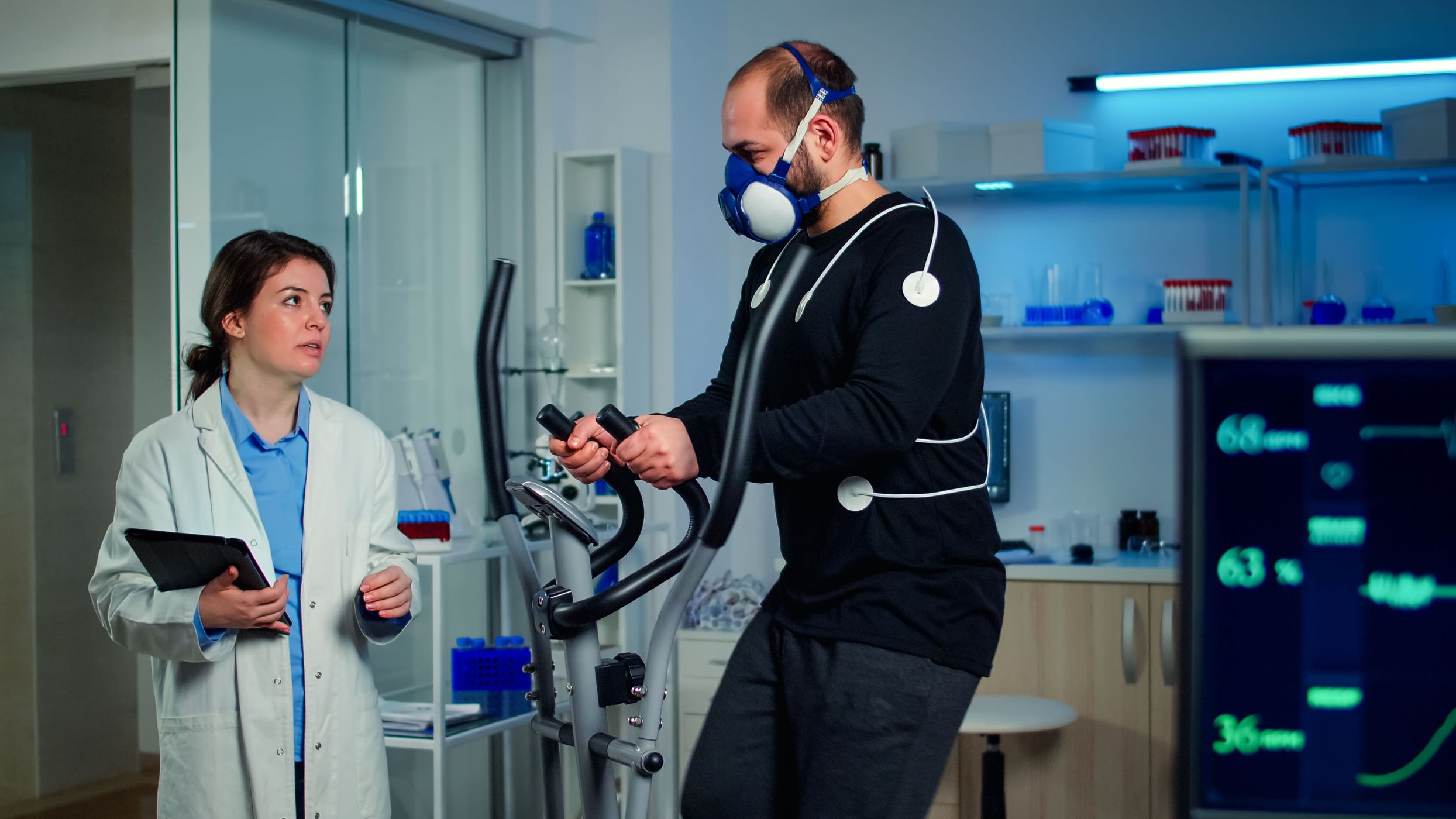Home>Misc>Featured>Which Is Considered To Be The Best Indicator Of Cardiovascular Fitness?


Featured
Which Is Considered To Be The Best Indicator Of Cardiovascular Fitness?
Modified: August 21, 2023
Discover the featured indicator for cardiovascular fitness, the ultimate reflection of your heart's health. Find out which one is considered the best for assessing your fitness level.
Introduction
Cardiovascular fitness, often referred to as cardiovascular endurance or aerobic fitness, is a measure of how efficiently your body can deliver oxygen and nutrients to your muscles during prolonged physical activity. It is an important aspect of overall fitness and plays a crucial role in maintaining good health. Improving cardiovascular fitness can have numerous benefits, including a reduced risk of chronic diseases, improved energy levels, and enhanced mental well-being.
When it comes to assessing cardiovascular fitness, there are several indicators that can provide valuable insights into an individual’s level of fitness. These indicators help determine how well the cardiovascular system is functioning and how effectively the body can transport oxygen to the muscles.
In this article, we will explore some of the most commonly used indicators of cardiovascular fitness, including heart rate, VO2 max, METs, resting heart rate, and maximum heart rate. By understanding these indicators, you can better evaluate your cardiovascular fitness and make informed decisions about your exercise routine and overall health.
Definition of Cardiovascular Fitness
Cardiovascular fitness, also known as cardiovascular endurance or aerobic fitness, refers to the ability of the cardiovascular system to deliver oxygen and nutrients to the working muscles during physical activity. It is a measure of how efficiently your body can sustain prolonged periods of exercise that require the continuous supply of oxygen to meet the demands of muscle tissues.
When you engage in activities like running, cycling, swimming, or any other form of aerobic exercise, your heart pumps blood more efficiently, delivering oxygen and nutrients to your muscles. This improved circulation helps your muscles work more efficiently and enhances your overall endurance.
Cardiovascular fitness is determined by several factors, including the efficiency of the heart, the strength and flexibility of the blood vessels, and the ability of the muscles to utilize oxygen effectively. It is not solely determined by how long you can perform a certain activity, but also by how well your body can recover from the physical stress and adapt to increased exercise intensity over time.
Improving cardiovascular fitness requires regular aerobic exercise that increases your heart rate and makes you breathe harder. This sustained activity strengthens the cardiovascular system, allowing it to deliver oxygen-rich blood to the muscles more efficiently. As a result, your endurance improves, and you are able to engage in physical activities for longer periods without feeling fatigued.
Having good cardiovascular fitness has numerous benefits. It helps reduce the risk of chronic diseases such as heart disease, stroke, and diabetes. It also improves lung capacity, promotes healthy weight management, boosts overall energy levels, and enhances mental well-being.
Now that we have a clear understanding of what cardiovascular fitness is, let’s explore some of the key indicators used to assess and measure an individual’s level of cardiovascular fitness.
Importance of Cardiovascular Fitness
Cardiovascular fitness is an essential component of overall health and plays a crucial role in maintaining a healthy and active lifestyle. Here are some key reasons why cardiovascular fitness is important:
- Reduced risk of chronic diseases: Regular cardiovascular exercise helps reduce the risk of chronic conditions such as heart disease, stroke, high blood pressure, and diabetes. It improves the health of your heart, lowers cholesterol levels, and promotes healthy blood flow throughout the body.
- Improved endurance and stamina: Enhancing cardiovascular fitness improves your endurance and stamina, allowing you to engage in physical activities for longer durations without feeling fatigued. This increased endurance is beneficial not only for athletic performance but also for your daily activities and tasks.
- Enhanced energy levels: Regular aerobic exercise helps increase oxygen delivery to your muscles, improving their ability to produce energy. This leads to increased energy levels throughout the day, making you feel more alert and productive.
- Weight management: Cardiovascular exercise plays a vital role in maintaining a healthy weight or losing excess weight. It helps burn calories and fat, aiding in weight loss. Combined with a balanced diet, it can help you achieve and maintain a healthy body weight.
- Improved mental well-being: Engaging in cardiovascular exercise releases endorphins, also known as “feel-good” hormones, which can boost your mood and reduce symptoms of anxiety and depression. Regular exercise has been found to improve cognitive function, reduce stress, and enhance overall mental well-being.
- Increased lung capacity: Cardiovascular exercise increases the efficiency of your respiratory system, improving the capacity of your lungs to take in and utilize oxygen. This can be particularly beneficial for individuals with respiratory conditions such as asthma.
Overall, cardiovascular fitness is vital for supporting optimal health and well-being. By improving your cardiovascular fitness, you can enhance your quality of life, decrease the risk of disease, and enjoy the numerous physical and mental benefits associated with a healthy cardiovascular system.
Benefits of Improving Cardiovascular Fitness
Improving cardiovascular fitness through regular aerobic exercise offers a wide range of benefits that contribute to your overall health and well-being. Let’s explore some of the key advantages:
- Increased endurance: One of the primary benefits of improving cardiovascular fitness is increased endurance. As your cardiovascular system becomes more efficient at delivering oxygen to your muscles, you will be able to sustain physical activity for longer durations without tiring quickly. This can significantly enhance your performance in various sports and everyday activities.
- Enhanced cardiovascular health: Regular aerobic exercise strengthens not only your muscles but also your heart. It improves the function and efficiency of the heart, reducing the risk of heart disease and other cardiovascular conditions. It also helps lower blood pressure and cholesterol levels, promoting a healthier cardiovascular system.
- Weight management: Aerobic exercise is an effective tool for managing body weight. It helps burn calories and fat, which can contribute to weight loss and weight maintenance. Combining cardiovascular exercise with a healthy diet can lead to better weight management and improved body composition.
- Improved lung function: Engaging in cardiovascular activities increases the demand for oxygen, which promotes better lung function. Over time, this can lead to increased lung capacity and improved respiratory efficiency. Individuals with respiratory conditions such as asthma may benefit from improved lung function through regular aerobic exercise.
- Stress reduction: Cardiovascular workouts release endorphins, also known as the “feel-good” hormones, which can help reduce stress and boost mood. Regular exercise has been shown to improve mental well-being and reduce symptoms of anxiety and depression.
- Greater energy levels: Regular aerobic exercise improves circulation and the delivery of oxygen and nutrients to your muscles. This leads to better energy production within the body, resulting in increased energy levels. You’ll feel more alert and energized throughout the day, improving overall productivity.
- Long-term health benefits: Engaging in regular aerobic exercise has long-term health benefits. It can reduce the risk of developing chronic conditions such as type 2 diabetes, certain types of cancer, and metabolic syndrome. It also improves bone density, which is crucial for preventing osteoporosis.
By investing time and effort into improving your cardiovascular fitness, you can reap these numerous benefits and enjoy a healthier, more active lifestyle. Incorporate aerobic exercise into your routine and gradually increase the intensity and duration to experience these positive changes.
Different Indicators of Cardiovascular Fitness
There are several indicators that can be used to assess and measure an individual’s cardiovascular fitness. These indicators provide valuable insights into the efficiency of the cardiovascular system and how well the body can transport oxygen during physical activity. Let’s take a closer look at some of the commonly used indicators:
- Heart rate: Heart rate is a widely used indicator of cardiovascular fitness. It measures the number of times your heart beats per minute during rest and exercise. A lower resting heart rate and a quicker return to resting heart rate after exercise generally indicate a higher level of cardiovascular fitness.
- VO2 max: VO2 max, or maximal oxygen consumption, is considered the gold standard for measuring cardiovascular fitness. It represents the maximum amount of oxygen your body can use during intense exercise. A higher VO2 max indicates a greater capacity to deliver oxygen to the muscles and is a strong indicator of cardiovascular fitness.
- METs (metabolic equivalents): METs are a way to measure the intensity of physical activity based on the amount of oxygen required. One MET is defined as the amount of oxygen consumed at rest, while higher MET values represent higher levels of energy expenditure. Monitoring METs can help assess the intensity of an activity and gauge cardiovascular fitness improvements over time.
- Resting heart rate: Resting heart rate is the number of times your heart beats per minute when you are at rest. A lower resting heart rate generally indicates better cardiovascular fitness. Regular aerobic exercise can lower resting heart rate by strengthening the heart and making it more efficient.
- Maximum heart rate: Maximum heart rate is the highest heart rate you can achieve during intense exercise. It can be used as a reference point to gauge the intensity of your workouts. Monitoring your maximum heart rate during exercise can help ensure you are working at an appropriate intensity to improve cardiovascular fitness.
While these indicators can provide valuable insights into an individual’s cardiovascular fitness level, it is important to note that they are not the sole determining factors. Other factors, such as age, genetics, and overall health, can also influence cardiovascular fitness. It is recommended to consult with a healthcare professional or fitness expert to assess your cardiovascular fitness accurately and devise an appropriate exercise plan to improve it.
Heart Rate as an Indicator
Heart rate is one of the most commonly used indicators of cardiovascular fitness. It measures the number of times your heart beats per minute, both at rest and during physical activity. Monitoring your heart rate can provide valuable insights into your fitness level and the efficiency of your cardiovascular system.
Resting Heart Rate: Your resting heart rate is the number of times your heart beats per minute when you are at rest. Normally, a lower resting heart rate indicates better cardiovascular fitness. Regular aerobic exercise can lower resting heart rate by strengthening the heart and making it more efficient. For most adults, a resting heart rate between 60 and 100 beats per minute is considered normal, but highly trained athletes may have resting heart rates below 60 beats per minute due to their high level of cardiovascular fitness.
Exercising Heart Rate: During physical activity, your heart rate increases to meet the oxygen and nutrient demands of your working muscles. Monitoring your heart rate during exercise can help you determine the intensity of your workout. The target heart rate zone, typically expressed as a percentage of your maximum heart rate, is often used to guide exercise intensity for cardiovascular fitness. Calculating your target heart rate zone can help ensure that you are exercising at an appropriate intensity to improve your cardiovascular fitness.
Recovery Heart Rate: After finishing a bout of exercise, your heart rate should gradually return to its resting state. The rate at which your heart rate declines during the recovery phase can indicate your level of cardiovascular fitness. A quicker return to your resting heart rate after exercise suggests a higher level of fitness, as it indicates that your heart and cardiovascular system recover more efficiently.
Monitoring your heart rate can be done manually by counting the beats for a certain duration or by using a heart rate monitor, which provides continuous heart rate measurements. Keep in mind that individual variations exist, and your heart rate may be influenced by factors such as age, fitness level, medications, stress, and hydration status.
By tracking your heart rate during exercise and noting changes in your resting heart rate over time, you can gain valuable insights into the improvements in your cardiovascular fitness. As you engage in regular aerobic exercise, your heart becomes stronger and more efficient, resulting in a lower resting heart rate and a quicker recovery heart rate. These adaptations indicate improved cardiovascular fitness.
Incorporate exercises that elevate your heart rate, such as running, cycling, swimming, or brisk walking, into your fitness routine. Aim to spend time within your target heart rate zone to challenge your cardiovascular system and improve its efficiency. Consistency and gradually increasing the duration and intensity of your workouts will help improve your cardiovascular fitness and optimize your heart rate responses.
VO2 max as an Indicator
VO2 max, or maximal oxygen consumption, is considered the gold standard for measuring an individual’s cardiovascular fitness level. It represents the maximum amount of oxygen that your body can utilize during intense exercise. Monitoring VO2 max provides valuable information about the capacity of your cardiovascular system to deliver oxygen to your working muscles.
Measurement of VO2 max: VO2 max is typically measured during a graded exercise test, where the intensity of exercise is gradually increased while monitoring oxygen consumption, carbon dioxide production, and heart rate. This test is usually performed in a laboratory setting with specialized equipment. However, estimates of VO2 max can also be obtained through field tests and fitness assessment protocols.
Interpreting VO2 max scores: VO2 max is expressed in milliliters of oxygen per kilogram of body weight per minute (ml/kg/min). Elite athletes and highly trained individuals often display high VO2 max scores, indicating a greater ability to transport oxygen to their muscles. On the other hand, sedentary individuals or those with lower levels of cardiovascular fitness tend to have lower VO2 max scores.
Significance of VO2 max: VO2 max is a strong predictor of cardiovascular health and endurance performance. A higher VO2 max indicates a more efficient oxygen delivery system and a greater capacity for sustained exercise. Individuals with higher VO2 max scores are generally able to perform at higher intensities for longer durations without experiencing excessive fatigue.
Improving VO2 max: Regular aerobic exercise is the key to improving and increasing your VO2 max. Engaging in activities that elevate your heart rate and challenge your cardiovascular system, such as running, cycling, swimming, and high-intensity interval training, can help improve your VO2 max. By consistently pushing your cardiovascular system to work harder, you can stimulate adaptations that enhance your overall fitness level.
Limitations of VO2 max: It’s important to note that VO2 max is influenced by factors such as genetics, age, gender, and overall health. Additionally, VO2 max can be affected by individual motivation and effort during testing. However, it remains a valuable indicator for comparing and assessing cardiovascular fitness levels.
Monitoring and improving your VO2 max can be an effective way to gauge your cardiovascular fitness level and track progress over time. While VO2 max testing may not be readily accessible to everyone, consistent aerobic exercise and fitness assessments can still provide insights into improvements in your cardiovascular fitness. Focus on activities that challenge your cardiovascular system and gradually increase the intensity and duration of your workouts to enhance your VO2 max and overall aerobic capacity.
METs (Metabolic Equivalents) as an Indicator
METs, or metabolic equivalents, are a way to measure the intensity of physical activity based on the amount of oxygen required. One MET is defined as the amount of oxygen consumed at rest, which is equivalent to the energy expenditure of sitting quietly and doing nothing. METs provide a standardized unit to compare the energy cost of different activities and can be used as an indicator of cardiovascular fitness.
How METs are calculated: METs are typically calculated by dividing the energy cost of an activity by the resting metabolic rate, which is the rate at which your body expends energy at rest. The American College of Sports Medicine provides a compendium that assigns MET values to various activities, allowing individuals to estimate the intensity of their exercise based on METs.
Interpreting MET levels: MET levels can be used to determine the intensity of different activities. Activities with higher MET values require more energy expenditure and involve a higher intensity level. For example, walking at a brisk pace may have a MET value of 3-4, while running can have a MET value of 8 or above. Monitoring MET levels during exercise can help individuals gauge the intensity of their workouts and assess their cardiovascular fitness.
Improving MET levels: As you engage in regular aerobic exercise and increase your cardiovascular fitness, you may find that your body becomes more efficient at utilizing oxygen and energy. This can lead to a decrease in the MET value for a given activity, as your body requires less energy to perform it. Continuously challenging yourself with more intense activities or increasing the duration and intensity of your current workouts can help improve your MET levels over time.
Benefits of using METs as an indicator: Using METs as a measure of cardiovascular fitness provides several benefits. It allows for easy comparison of the intensity of different activities, making it a useful tool for individuals looking to manage their energy expenditure or plan their workouts. Additionally, tracking MET levels over time can help you monitor your progress and set specific goals to improve your cardiovascular fitness.
Considerations when using METs: While METs can provide a general measure of activity intensity, it is important to remember that individual fitness levels can influence how your body responds to a specific activity. Factors such as age, weight, and overall health can affect your MET levels. Additionally, MET values are based on averages and may not accurately reflect the actual energy expenditure of every individual.
By understanding and monitoring METs during your exercise routine, you can gain insights into the intensity of your workouts and assess your cardiovascular fitness level. Aim to engage in activities that increase your MET level over time, challenging your cardiovascular system and improving your overall fitness.
Resting Heart Rate as an Indicator
Resting heart rate refers to the number of times your heart beats per minute when your body is at rest. It is an important indicator of cardiovascular fitness and overall health. Monitoring your resting heart rate can provide valuable insights into the efficiency of your cardiovascular system and the level of fitness you have achieved.
Interpreting resting heart rate: A lower resting heart rate generally indicates a higher level of cardiovascular fitness. Well-trained athletes often have resting heart rates below the average range of 60-100 beats per minute. This is because regular exercise strengthens the heart muscle, enabling it to pump a larger amount of blood with each beat. As a result, the heart doesn’t need to work as hard at rest, leading to a lower resting heart rate.
Factors influencing resting heart rate: Resting heart rate can be influenced by various factors including age, fitness level, genetics, and overall health. With regular exercise, you can expect your resting heart rate to decrease over time as your cardiovascular system becomes more efficient. However, it’s important to note that certain medications, stress, illness, and fatigue can temporarily elevate resting heart rate.
Benefits of monitoring resting heart rate: Monitoring your resting heart rate can provide several benefits. Firstly, it serves as a gauge of your cardiovascular fitness level. If your resting heart rate decreases over time, it indicates that your heart has become more efficient at pumping blood, a sign of improved fitness. Tracking changes in your resting heart rate can also help you identify factors that may affect your cardiovascular health, such as stress or illness.
Using resting heart rate to monitor progress: As you consistently engage in cardiovascular exercise, your resting heart rate may gradually decrease. By tracking your resting heart rate over time, you can assess your progress and the effectiveness of your training program. It’s important to note that significant changes in resting heart rate may not be observed in the short term. However, monitoring your resting heart rate over several weeks or months can provide a clearer picture of your progress.
Improving resting heart rate: Regular aerobic exercise is the key to improving resting heart rate. By engaging in activities that elevate your heart rate such as running, cycling, swimming, or brisk walking, you encourage your heart to become stronger and more efficient. Over time, this can lead to a lower resting heart rate. It’s important to maintain consistency with your exercise routine and gradually increase the duration and intensity of your workouts to see significant improvements.
Monitoring your resting heart rate can provide valuable insights into your cardiovascular fitness and overall health. By consistently tracking changes in your resting heart rate, you can assess your progress, identify potential factors impacting your heart health, and make informed decisions about your exercise routine and overall well-being.
Maximum Heart Rate as an Indicator
Maximum heart rate (MHR) is the highest number of times your heart can beat per minute during intense physical activity. It is an important indicator used to assess cardiovascular fitness and determine exercise intensity levels. Calculating and monitoring your maximum heart rate can provide valuable insights into your fitness level and help guide your training regimen.
Estimating maximum heart rate: The most common method to estimate MHR is by subtracting your age from 220. However, it’s important to note that this method provides a general estimate, and there can be individual variations. Factors such as fitness level, genetics, and overall health may affect your actual maximum heart rate.
Using maximum heart rate for exercise: Maximum heart rate is often used to guide exercise intensity. By working within a specific target heart rate zone (usually a percentage range of your MHR), you can ensure you are challenging your cardiovascular system without overexertion. Different target heart rate zones can be prescribed for various training goals, such as fat burning, endurance improvement, or high-intensity workouts.
Individual variations: It’s important to remember that maximum heart rate can vary among individuals, even of the same age. Some people may naturally have a higher MHR, while others may have a slightly lower one. Genetics, fitness level, and overall health can contribute to these variations. So, it’s essential to listen to your body and adjust your exercise intensity based on your personal level of exertion.
Assessing cardiovascular fitness: Maximum heart rate can also be used as an indicator of cardiovascular fitness. Generally, individuals with higher levels of cardiovascular fitness tend to have a higher MHR. This is because a well-conditioned heart can pump more blood with each beat, resulting in a higher maximum heart rate. Tracking changes in your MHR over time can provide insights into your cardiovascular fitness progress.
Improving maximum heart rate: Unlike resting heart rate, which tends to decrease with improved fitness, maximum heart rate is less likely to change significantly with training. Improving cardiovascular fitness primarily focuses on enhancing cardiac efficiency, stroke volume, and oxygen utilization rather than increasing the maximum heart rate. However, engaging in regular aerobic exercise can improve the overall health and function of your cardiovascular system.
Using caution: While maximum heart rate is a useful indicator, it’s important to exercise caution when approaching and reaching your MHR. Pushing yourself to your maximum heart rate for a prolonged period or without proper monitoring may increase the risk of injury or overexertion. Consult with a healthcare professional or exercise specialist to determine the appropriate target heart rate zone and ensure safety during your workouts.
Monitoring your maximum heart rate can help you gauge your cardiovascular fitness level and guide your exercise intensity. Understanding your MHR and working within the recommended target heart rate zones can assist in achieving your fitness goals, whether they be improving endurance, burning calories, or enhancing overall cardiovascular health.
Conclusion
Cardiovascular fitness is a crucial component of overall health and well-being. By improving cardiovascular fitness, you can enhance your endurance, reduce the risk of chronic diseases, boost energy levels, and improve mental well-being. To evaluate and track cardiovascular fitness, several indicators can be used, including heart rate, VO2 max, METs, resting heart rate, and maximum heart rate.
Heart rate, both at rest and during exercise, provides insights into your cardiovascular health and fitness level. Monitoring changes in heart rate can help gauge improvements in cardiovascular efficiency and endurance. VO2 max, considered the gold standard for assessing cardiovascular fitness, determines the maximum amount of oxygen your body can use during intense exercise. METs, on the other hand, are used to measure the intensity of physical activity based on the amount of oxygen required.
Resting heart rate and maximum heart rate are also commonly used indicators of cardiovascular fitness. A lower resting heart rate suggests better cardiovascular fitness, while maximum heart rate helps determine exercise intensity levels. Monitoring these indicators and tracking their changes over time can provide valuable insights into your cardiovascular fitness level, progress, and overall health.
It’s important to note that individual variations, such as age, genetics, and overall health, can influence these indicators. Therefore, it is recommended to consult with a healthcare professional or fitness expert to assess your cardiovascular fitness accurately and devise an appropriate exercise plan to improve it.
By understanding and utilizing these indicators, you can effectively evaluate and improve your cardiovascular fitness. Incorporate regular aerobic exercises, progressively increase the intensity and duration of your workouts, and monitor changes in these indicators to optimize your cardiovascular health and achieve your fitness goals.








